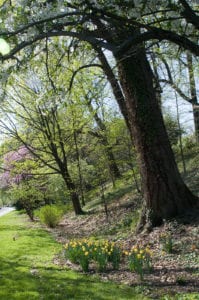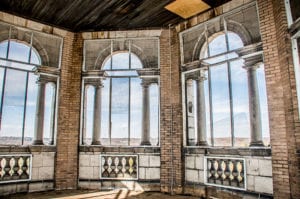This story appeared in the Winter 2016 edition of the Roland Park News.
Open Space Campaign Update.
RPCF Increases Leadership Role in Roland Water Tower Restoration.
The Roland Park Community Foundation (RPCF) has recently increased its leadership role in the restoration of the Roland Water Tower to help move the project forward. The Board voted to oversee the construction of the project and hired a construction manager whose experience includes the Project Manager of the reconstruction of the Washington Monument in Mount Vernon. The 2010 Greater Roland Park Master Plan identified the Tower’s restoration as one of the most urgent Open Space projects, and after years of working with the City, the RPCF felt the need to step up their role if it was ever to see the restoration completed.
To recap the progress so far, in 2011, the RPCF, under the leadership of Ken Rice, secured a matching $2,500 grant from The Heritage Fund, a joint program sponsored by Preservation Maryland and the Maryland Historical Trust, to perform a structural analysis of the Tower. The Friends of the Water Tower donated $250 to the $2,250 provided by the Foundation. The study determined that the structure was essentially sound and that the Tower could be restored.
In the fall of 2011, the 41st and 42nd Legislative teams in Annapolis came to the community and proposed the initiation of a Bond Bill in the 2012 Session toward the restoration of the Tower, subject to the community’s willingness to match the Bond Bill. The RPCF voted to pledge the funds to match the Bond Bill. Matthew Fitzsimmons and Elisabeth Sachs, two individuals on the leadership team, went down to Annapolis to testify on behalf of the Bond Bill and the City was awarded $250,000 toward the restoration of the Tower.
In October 2012, the RPCF spent $37,000 to remove decades of dirt and debris inside the Tower. Workers in hazard material suits swept, scrubbed and secured the building with screens to preventing birds from returning. This first step in the restoration process allowed contractors and architects to gain safe access to the building.
Due to its original function, the Roland Water Tower still fell under the auspices of the Department of Public Works (DPW), although City monuments are usually the responsibility of the Department of General Services (DGS). DGS said they were willing to have the Roland Water Tower transferred to them, but only if it came with some funding. The DPW team agreed to transfer the funds set aside to demolish the Tower, referred to as “virtual demolition funds,” over to DGS. This transfer process took many months and persistent phone calls from RPCF board member Al Copp, but it was finally completed on March 27, 2013. The Board of Estimates approved the transfer of $337,000 from the Department of Public Works to the Department of General Services for the restoration of the Tower, subject to a management agreement.
With the transfer in place, the project’s design phase could now begin. Three project stages were identified: Phase One, stabilizing and restoring the Tower; Phase Two, internal access to the top of the Tower; and finally, Phase Three, the creation of a pocket park at the base.
It is here that the project stalled. The initial design estimates for Phase One proved far higher than anticipated and Baltimore City did not accept the proposal. In April 2014, the Mayor’s Office suggested that the RPCF take on the design process to speed the process and save money. The RPCF worked with two different firms but both of the proposals were rejected. The first design firm was uncomfortable with doing the design work for one entity and then the construction work would be performed for a different entity. They placed exceptional requirements on the RPCF and after checking with legal counsel, these were rejected.
RPCF attempted to secure another acceptable design proposal, but ran into obstacles when the new design company requested scaffolding to complete the estimate. Scaffolding is one of the largest costs of this construction project but because the design was going to be paid for by the RPCF and not the City, the City would require the scaffolding be removed before it was erected again by the construction company. The costs associated with erecting and dismantling the scaffolding for both the design and the construction phases, which the RPCF, rather than the City, would have to absorb, were simply too high.
After more than two years of delays, it was clear that a new approach was needed. In early 2016, the City applied to receive an extension to the 2012 Bond Bill that authorized $250,000 in matching funds for the renovation of the Roland Water Tower. This presented an opportunity to request an amendment to the Bill, changing the recipient of the funds from Baltimore City to the Roland Park Community Foundation. Both the City and the RPCF Board approved this switch, which would increase RPCF’s responsibility for the overall project management.
At the RPCF’s March 2016 board meeting, a motion was made and approved to formally request the City to begin the transfer of the Roland Water Tower’s restoration to the Foundation. Later in the spring, members of the Roland Water Tower Committee met with City representatives, including Councilwomen Mary Pat Clarke, Sharon Green Middleton, and then-Deputy Mayor for Operations Khalil Zaied. An agreement was reached whereby the City would pay for the Phase One design estimate, thus enabling cost estimates to proceed. In July, the first draft of the design proposal put the estimated cost within the $837,000 available for the project.
The RPCF also agreed to oversee the construction phase and create a Memorandum of Understanding (MOU) with the City to determine the full scope of Phase One and their various financial responsibilities. To prevent further delays, the RPCF has recently hired Tom McCracken of McCracken Consulting, LLC to work with the City on its behalf and act as Project Manager during the Tower’s restoration. Mr. McCracken, a Roland Park resident, represented the Mount Vernon Conservancy during the restoration of the 200-year-old Washington Monument in Mount Vernon and has considerable experience with historic restoration projects in Baltimore City.
At present, Mr. McCracken is liaising with the City on the design contract with JMT, a multi-disciplined architectural and engineering company, to further refine the design proposal.
During its 111-year history, the Roland Water Tower has performed several practical and symbolic functions for the surrounding neighborhoods. Once restored, with a pocket park at the base, this iconic structure will take on a new role as an attractive local landmark and welcoming green space.







